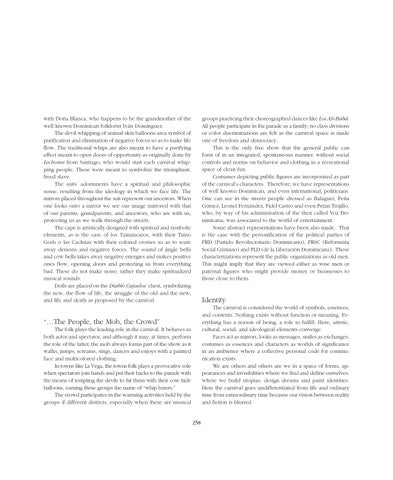groups practicing their choreographed dances like Los Alí-Babá. All people participate in the parade as a family; no class divisions or color discriminations are felt as the carnival space is made one of freedom and democracy. This is the only free show that the general public can form of in an integrated, spontaneous manner, without social controls and norms on behavior and clothing in a recreational space of clean fun. Costumes depicting public figures are incorporated as part of the carnival’s characters. Therefore, we have representations of well known Dominican, and even international, politicians. One can see in the streets people dressed as Balaguer, Peña Gómez, Leonel Fernández, Fidel Castro and even Petán Trujillo, who, by way of his administration of the then called Voz Dominicana, was associated to the world of entertainment. Some abstract representations have been also made. That is the case with the personification of the political parties of PRD (Partido Revolucionario Dominicano), PRSC (Reformista Social Cristiano) and PLD (de la Liberación Dominicana). These characterizations represent the public organizations as old men. This might imply that they are viewed either as wise men or paternal figures who might provide money or businesses to those close to them.
with Doña Blanca, who happens to be the grandmother of the well known Dominican folklorist Iván Domínguez. The devil whipping of animal skin balloons area symbol of purification and elimination of negative forces so as to make life flow. The traditional whips are also meant to have a purifying effect meant to open doors of opportunity as originally done by Lechones from Santiago, who would start each carnival whipping people. These were meant to symbolize the triumphant, freed slave. The suits’ adornments have a spiritual and philosophic sense, resulting from the ideology in which we face life. The mirrors placed throughout the suit represent our ancestors. When one looks onto a mirror we see our image mirrored with that of our parents, grandparents, and ancestors, who are with us, protecting us as we walk through the streets. The cape is artistically designed with spiritual and symbolic elements, as is the case of los Taimáscaros, with their Taino Gods o las Cachúas with their colored crosses so as to scare away demons and negative forces. The sound of jingle bells and cow bells takes away negative energies and makes positive ones flow, opening doors and protecting us from everything bad. These do not make noise; rather they make spiritualized musical sounds. Dolls are placed on the Diablo Cajuelos’ chest, symbolizing the new, the flow of life, the struggle of the old and the new, and life and death as proposed by the carnival.
Identity The carnival is considered the world of symbols, essences, and contents. Nothing exists without function or meaning. Everything has a reason of being, a role to fulfill. Here, artistic, cultural, social, and ideological elements converge. Faces act as mirrors, looks as messages, smiles as exchanges, costumes as essences and characters as worlds of significance in an ambience where a collective personal code for communication exists. We are others and others are we in a space of forms, appearances and invisibilities where we find and define ourselves, where we build utopias, design dreams and paint identities. Here the carnival goes undifferentiated from life and ordinary time from extraordinary time because our vision between reality and fiction is blurred.
“…The People, the Mob, the Crowd” The folk plays the leading role in the carnival. It behaves as both actor and spectator, and although it may, at times, perform the role of the latter, the mob always forms part of the show as it walks, jumps, screams, sings, dances and enjoys with a painted face and multicolored clothing. In towns like La Vega, the towns folk plays a provocative role when spectators join hands and put their backs to the parade with the means of tempting the devils to hit them with their cow hide balloons, earning these groups the name of “whip barers.” The crowd participates in the warming activities held by the groups if different districts, especially when these are musical
258
